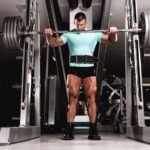Abdominal Twist Crunches Overview
The abdominal twist crunch is a dynamic core exercise designed to strengthen the abdominal muscles, with a particular emphasis on the obliques and rectus abdominis. Unlike the Russian twist, which involves a seated rotation, this exercise is performed lying down, combining a crunch with a controlled twist to target rotational core strength. It’s an excellent movement for improving core stability, enhancing functional movement, and supporting activities that involve torso rotation, such as sports or daily tasks. The abdominal twist crunch can be included in core workouts, full-body routines, or as a finisher to engage the abs effectively (Akuthota et al., 2008).
How to Perform the Abdominal Twist Crunch
- Lie flat on your back on an exercise mat or soft surface, with your knees bent and feet flat on the floor.
- Bend one knee to form a 90-degree angle and cross the opposite ankle over the bent knee, resting it just above the knee.
- Place your fingertips lightly behind your ears or on the sides of your head, avoiding pulling on your neck.
- Engage your core by lifting your shoulder blades slightly off the mat, keeping your lower back pressed into the floor.
- Perform a crunch by twisting your torso, bringing the elbow opposite to the raised knee toward it in a controlled motion.
- Slowly lower your upper body back down, stopping just before your shoulder blades touch the mat to maintain core tension.
- Complete the desired number of repetitions, then switch sides (e.g., opposite leg and elbow) and repeat the movement.
Tips for Optimal Performance
- Limit Hip Movement: Keep your hips stable and avoid lifting them off the mat to ensure the focus remains on your core muscles.ning or lifting, while sculpting a defined midsection.
- Avoid Neck Strain: Keep your fingertips lightly touching your head and use your core, not your neck, to initiate the crunch. Pulling on your neck can lead to discomfort or injury (McGill, 2010).
- Move Deliberately: Perform the twist and crunch slowly to maximize muscle engagement and minimize momentum, which ensures the obliques and abs do the work (Wirth et al., 2016).
- Maintain Core Tension: Stop short of fully relaxing at the bottom of the movement to keep your abs engaged throughout the set, enhancing muscle activation.
- Align Your Spine: Press your lower back gently into the mat to protect your spine and maintain proper posture during the twist.
- Breathe Properly: Exhale as you crunch and twist, and inhale as you lower back down to support controlled movement and oxygenate your muscles.
Sculpting your core with twist crunches? Discover how they enhance abs in our Ultimate Guide to Muscle Groups.







